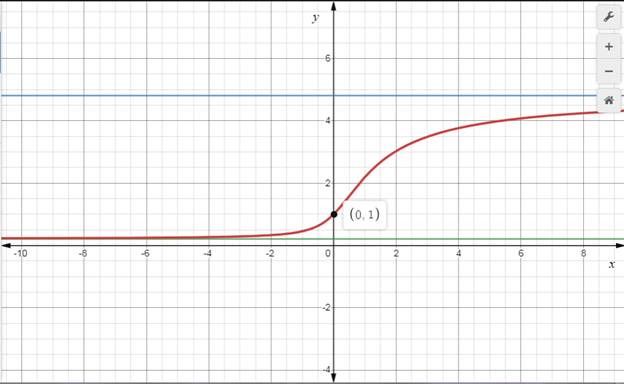
(a)
To find: The vertical and the horizontal asymptotes.
(a)
Answer to Problem 40E
The horizontal asymptotes are
Explanation of Solution
Given:
The function is
Calculation:
To find the horizontal asymptote, determine
So,
Since the function is a simple exponential function, no vertical asymptote exists.
(b)
To find: The intervals of increase and decrease.
(b)
Answer to Problem 40E
The function is increasing for all x .
Explanation of Solution
Given:
The function is
Calculation:
To find the intervals of increase and decrease, determine the derivative of
Since
(c)
To find: The
(c)
Answer to Problem 40E
No
Explanation of Solution
Given:
The function is
Calculation:
Since
(d)
To find: The intervals of concavity and the inflection points.
(d)
Answer to Problem 40E
The function
Explanation of Solution
Given:
The function is
Calculation:
To find the intervals of concavity, determine the second derivative of
Now to determine the points where
So,
(e)
To sketch: The graph of
(e)
Explanation of Solution
Given:
The function is
Calculation:
To graph of

Figure 1
Chapter 4 Solutions
Single Variable Calculus: Concepts and Contexts, Enhanced Edition
 Calculus: Early TranscendentalsCalculusISBN:9781285741550Author:James StewartPublisher:Cengage Learning
Calculus: Early TranscendentalsCalculusISBN:9781285741550Author:James StewartPublisher:Cengage Learning Thomas' Calculus (14th Edition)CalculusISBN:9780134438986Author:Joel R. Hass, Christopher E. Heil, Maurice D. WeirPublisher:PEARSON
Thomas' Calculus (14th Edition)CalculusISBN:9780134438986Author:Joel R. Hass, Christopher E. Heil, Maurice D. WeirPublisher:PEARSON Calculus: Early Transcendentals (3rd Edition)CalculusISBN:9780134763644Author:William L. Briggs, Lyle Cochran, Bernard Gillett, Eric SchulzPublisher:PEARSON
Calculus: Early Transcendentals (3rd Edition)CalculusISBN:9780134763644Author:William L. Briggs, Lyle Cochran, Bernard Gillett, Eric SchulzPublisher:PEARSON Calculus: Early TranscendentalsCalculusISBN:9781319050740Author:Jon Rogawski, Colin Adams, Robert FranzosaPublisher:W. H. Freeman
Calculus: Early TranscendentalsCalculusISBN:9781319050740Author:Jon Rogawski, Colin Adams, Robert FranzosaPublisher:W. H. Freeman
 Calculus: Early Transcendental FunctionsCalculusISBN:9781337552516Author:Ron Larson, Bruce H. EdwardsPublisher:Cengage Learning
Calculus: Early Transcendental FunctionsCalculusISBN:9781337552516Author:Ron Larson, Bruce H. EdwardsPublisher:Cengage Learning





